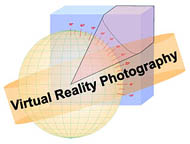 | Case Study: Review of VR Pan Heads
|
 | Case Study: Review of VR Pan Heads
|
![]()
Review by Scott Highton for Virtual Reality Photography (www.vrphotography.com)
November, 2003 (Updated December, 2004)
One of the more welcome recent advances in virtual reality photography was the addition of cubic panorama support within Apple’s popular QuickTime format several years ago. While it has been possible to create such panoramas by shooting with fisheye lenses and assembling iPIX or other fisheye based applications for some time, increased resolution panoramas can be made by shooting multi-row sequences with traditional rectilinear lenses and stitching panoramas with multi-row stitchers such as RealViz’s Stitcher.
In response to the demand for this multi-row shooting capability, the three leading manufacturers of VR panoramic heads have released new spherical/multi-row models. Each of them were kind enough to send their latest hardware to Virtual Reality Photography for an in-depth, side-by-side comparison.
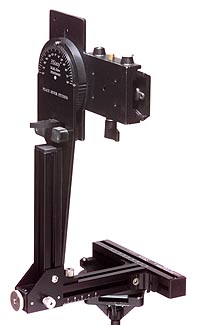 | 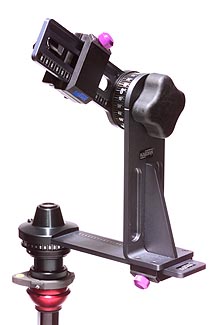 | 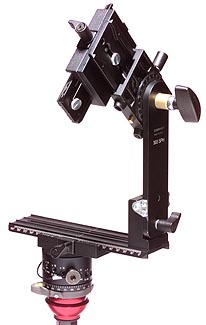 |
| Peace River Studios 3Sixty | Kaidan QuickPan III Spherical | Manfrotto 303 SPH (Spherical) |
We evaluated the heads based upon priorities common to many working photographers:
There were a number of elements that we attempted to quantify in the above areas. We considered other factors as well, many of which were prompted by our experiences during actual VR shoots.
| VR Head Model | Price | Weight | Approx. Packing Dimensions (width, height, depth) | Retain Nodal Pt.? | Minimal Spherical Shooting Clearance (radius, height) |
| Peace River Studios 3Sixty | $1,236.00 (Direct from Mfr. includes head and Multi-row Attachment) | 3 lbs. 15 oz. | 13" x 4.75" x 7.5" = 463 cu. inches | Yes | 16" x 18" |
| Kaidan QuickPan III (QR & stainless rotator) | $628.90 (Direct from Mfr.) $572.33 | 4 lbs. 12 oz. | 12.5" x 5.5" x 3.5" = 240 cu. inches (Rotator/am & vertical | No | 18" x 16.5" |
| Manfrotto 303SPH | $481.95 (B&H) | 4 lbs. 4 oz. 3 lbs. 6 oz. | 11" x 7" x 6" = 462 cu. inches (308 cu. inches without | Yes | 18" x 15.5" |
![]()
Price
Peace River Studio’s 3Sixty (with Multi-row Attachment) is by far the most expensive of the three heads. At $1,236.00 (direct from Peace River) for the combination of the head and Multi-row Attachment, it costs almost twice as much as either of the Kaidan or Manfrotto heads. Peace River indicated that a modest price reduction for their Multi-Row Attachment would be expected in the Sping of 2004, and that the design of this Attachment will be stronger and lighter than the model tested for this review. Kaidan offers its QuickPan III Spherical head in a number of configurations with varying prices. They asked that we use the stainless steel rotator with an Arca-Swiss Quick Release configuration for our comparison because it it the most robust of their models and is intended for professional use. This combination is priced at $628.90 direct from Kaidan, but a lower priced configuration (with an aluminum rotator and universal camera mount) is priced at $558.95. Kaidan products are also available through a variety of resellers, including B&H Photo in New York, at slightly lower prices. (Kaidan also offers substantial discounts on hardware/software bundles purchased directly.) The Manfrotto 303SPH is probably the least expensive of the spherical heads. It has a suggested retail price of $683, but can be found for far less through Manfrotto/Bogen resellers. (B&H Photo advertises it for $481.95).
![]()
Size and Weight
These are important considerations for photographers having to carry their equipment in the field. For the average photographer, a 20 pound shoulder bag is about as much as can be carried comfortably for an extended period, such as on a photojournalism assignment. Twenty pounds of camera equipment is also a significant addition to the load a backpacker would normally carry (a 35-40 lb. backpack is pushing the limit of extended comfort on the trail.) The amount of space a VR head takes in your camera bag, combined with how much it adds to the weight you must carry, can often make the difference between whether your VR gear gets included or not.
While these new heads are significantly improved over previous models, weight is still a bit of a problem. They all weigh about 4 pounds, which winds up being about 20 percent of the comfortable camera bag load. Add to that the weight of a tripod and a leveling device, along with camera and lens, and there’s not much allowance left for other gear.
The Peace River 3Sixty and the Kaidan QuickPan III Spherical (with Aluminum rotator) both weigh 3 lbs. 15 oz. The stronger stainless steel rotator for the QPIII increases its total weight to 4 lbs. 12 oz. The Manfrotto 303SPH weighs 4 lbs. 4 oz. However, if your camera has its tripod socket aligned directly under the center of the lens mount, you can remove the top assembly of the Manfrotto head (which is used only for camera offset) and reduce its total weight to 3 lbs. 6 oz. – making it the lightest of the three heads. (Note that this option is not currently described in the Manfrotto user manual, but removal of this assembly was the first thing we did before using the head with our cameras. For camera offset, we use a Nikon AH-2 plate weighing only 3 oz. to properly align the tripod socket on our F3 and MD-4 motor drive.)
![]()
Storage Space
All three manufacturers have now included the ability to collapse or fold their VR heads for packing and transport. Earlier models had large metal pieces fixed at right angles to one another, which made packing the heads into a camera bag difficult at best. For this review, we measured the minimum space that the heads could be packed into when collapsed. Since most VR photographers use a single camera and lens combination for the majority of their panoramic work, we also looked at whether a preset nodal point alignment could be maintained when the heads were folded. One of the long time aggravations of VR shooting is having to realign your camera’s nodal point every time you set the head up. This slows down your shooting process and introduces one more possibility for error (forgetting to realign) that may not be discovered until after the fact. It’s better to be able to set and lock your nodal point alignment in a more controlled and low pressure environment than during an actual shoot, and then to know that the head is already pre-aligned when you set it up again.
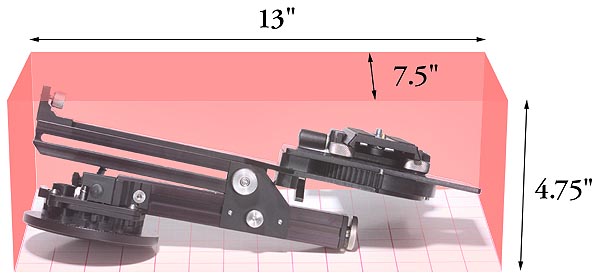 |
| Peace River Studios' 3Sixty head folded for storage |
The Peace River 3Sixty and the Manfrotto 303SPH both took up a similar volume when measured in width, height and depth. From these dimensions, we determined the space required for storage in cubic inches. However, it is important to note that the total volume of the heads is less than these numbers – these dimensions are simply the size of the container or section of a camera bag that the folded heads will fit into. It may be possible to pack other items in the spaces within and around the folded heads.
The Peace River 3Sixty required approximately 463 cu. in. of storage space, while the Manfrotto 303SPH required 462 cu. in. However, if the Manfrotto head’s top assembly is removed (when your camera’s tripod socket is aligned with the center of the lens), only 308 cu. in. are required. The Kaidan QuickPan III head collapses into the smallest storage space of 240 cu. in., but this is because the vertical arm and camera plate assemblies have to be fully removed from the rotator and its arm. The disadvantage of this is that nodal point alignment is lost. There is a good graduated scale imprinted on the rotator arm, so it is possible to note or mark the aligned position and return to it quickly during reassembly. (Kaidan designed the head this way in response to user requests for a quick way to change camera brackets, such as when going from a fisheye lens to a multi-row set up.) However, when the Peace River and Manfrotto heads are folded, the nodal point alignment is usually maintained, so everything remains aligned the next time the head is set up.
![]()
Operation Space
The space required to use the heads when assembled is another important consideration for some photographers, particularly those shooting in confined spaces such as aircraft cockpits or automobile interiors. We therefore measured the movement of the assembled head throughout its pan and tilt ranges. Additional clearance space is also needed to allow for a camera support (such as a tripod), head leveling mechanism and of course photographer access.
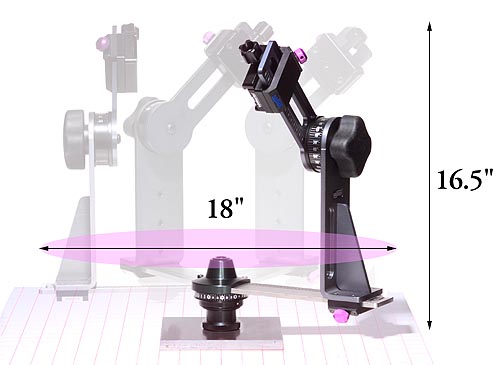 |
| Kaidan QuickPan III minimum space for multi-row shooting |
Surprisingly, we found all three heads required similar working spaces. The Kaidan QPIII required a clearance of 18” wide x 18” deep x 16-1/2” high. The Manfrotto 303SPH required 18”w x 18”d x 15-1/2h”, which was the shortest headroom requirement. The Peace River 3Sixty had the smallest operating radius of 16”w x 16”d x 18”h.
Both the Peace River and Manfrotto heads can be configured for even smaller spaces, if your camera alignment allows it. Peace River is willing to cut custom rail sections (the stock 3Sixty is designed with three matching 6-5/8" long extruded aluminum arms) for an additional price. However, the Manfrotto 303SPH comes standard with two interchangeable sets of plates (5-1/2" and 8-1/4" long). Choose the shorter ones to save on size and weight, as long as they provide the alignment space your camera needs. Otherwise, use the longer plates or a combination of both.
![]()
Design and Function
| VR Head Model | Deflection under 5 lb. load | Controls Simplicity | Cold Weather / Glove Function | General Construction | Captive Parts? | Other Tools Needed |
| Peace River Studios 3Sixty | 0.8° | 12 knobs/levers for 6 functions 3 for detent settings | Moderate | Moderate | Yes | Flat head screwdriver or coin |
| Kaidan QuickPan III (QR & stainless rotator) | 0.6° | 5 knobs/screws for 6 functions 1 detent tension | Very Good | Good | Yes | Flat head screwdriver or coin 5/32" Allen wrench (QR plate attachment) |
| Manfrotto 303SPH | 1.2° | 8 knobs for 7 functions 2 detent, tension, lock | Very Good | Good | No (Vertical lock knob) | Flat head screwdriver or coin |
![]()
Satisfaction with design and function of VR equipment is often subjective at best. Photographers will frequently choose hardware based on its general “feel” and whether it performs its needed functions effectively and simply. Confusing mechanisms that require modification or extra effort in the field merely increase the workload for the photographer, and they present further potential for failure in what may already be high pressure shooting situations.
![]()
Deflection (Sag) Under Load
The first criteria we looked at was the strength of the heads. To quanitfy this, we measured how far out of “square” each head deviated when burdened with the weight of a camera and lens combination.
This is a typical shooting problem, because image sequences shot with the camera as little as half a degree (0.5°) off of vertical alignment can cause noticeable stitching errors at higher resolution assemblies. Even though the tripod head may be perfectly level, the camera itself may not be vertical if there is too much flex in the brackets holding the camera. If the camera is rotated off axis, the horizon lines between shots will not properly match up and the stitched panorama will wind up with a “stair stepped” assembly.
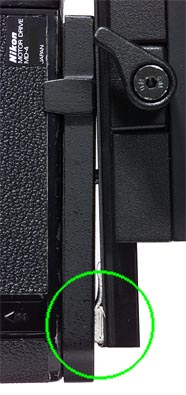 | |
| Manfrotto 303SPH head being measured for "sag" under weight of Nikon F3 camera and 15mm nikkor lens (approx. 5 lbs.) | A folded piece of tape can be used between camera base and plate to correct for "sag" |
![]()
For this test we attached a Nikon F3 with MD-4 motor drive and 15mm Nikkor lens (total weight: about 5 lbs.) to each head and measured the deflection between the vertical film plane of the camera and the leveled base. Many photographers also rest their hand on the camera while shooting, inadvertently adding weight and tilting the camera even more. (This is another reason to use a remote or cable release so you avoid touching the camera during each exposure.) Thus, relative strength and stiffness of the VR head is fairly crucial.
All three of the heads exhibited noticeable “sag” or deviation under the 5 lb. camera load. The one with the least amount was the Kaidan QuickPan III (with stainless steel rotator). It deviated about 1/2 of a degree off of vertical. Next were the Kaidan QuickPan III (with aluminum rotator) and the Peace River 3Sixty, which both sagged about 3/4 of a degree. The worst deviation was with the Manfrotto 303SPH, which sagged well over a full degree off vertical.
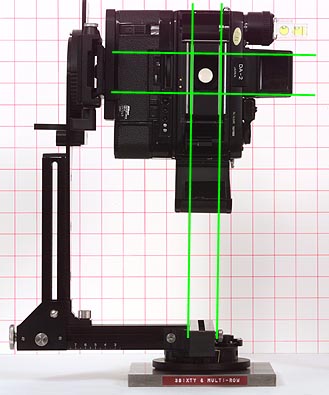 | 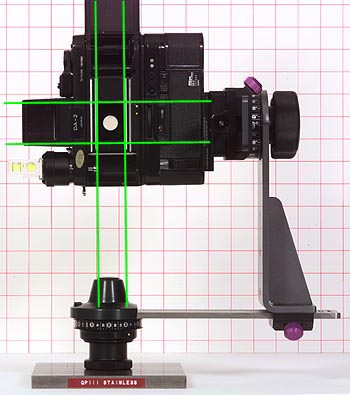 |
| Peace River's 3Sixty under camera weight | Kaidan's QuickPan III under camera weight |
It is possible to correct for these deviations, assuming you know about them, by simply adding one or more pieces of tape (or some other shim) under one end of the camera base when mounting it to the attachment plate. However, we’d prefer to see heads that hold their shape better under professional camera loads. Unfortunately, this seems to require designs made from thicker/heavier materials. A one degree alignment error is difficult to detect through a viewfinder under normal shooting conditions, yet it can be problematic for many stitching applications. In our opinion, photographers shouldn’t be expected to cobble together pieces of tape on state-of-the-art hardware to properly align everything.
![]()
Operation Complexity & General Construction
Next, we looked at the complexity of operation. In practical use, the size/number of knobs and their relation to the adjustments available correspond directly to the ease of use of the head. It is generally preferable to loosen or tighten the least number of knobs for each adjustment, and to have those knobs sized adequately to allow their use by a photographer wearing gloves during cold weather shooting.
The Kaidan QuickPan III head is probably the simplest in this regard. Its use requires five knobs or screws to adjust six major functions and movements. Each of these knobs is large enough to be loosened and tightened easily with heavy gloves on. We particularly liked the size of the tilt arm control knob.
Unfortunately, changing the detent settings on the QuickPan III is not so easy. To do this, you need to completely remove and replace the detent ring. This requires removal of the head from the tripod and depression of a rather small, recessed plunger in order to release the original ring. This may require a small but strong tool such as an Allen wrench or jeweler’s screwdriver. Although Kaidan indicates it should be possible using the point of a ballpoint pen, we were unable to do it without something a little stronger. On the other hand, most photographers use the same camera/lens combination most of the time and thus, may not need to change this detent ring frequently.
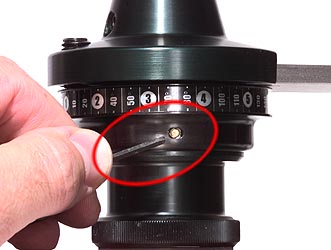 | 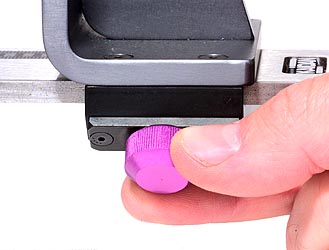 |
| Changing QuickPan III detent rings requires a small tool | QuickPan III adjustment knobs are well sized |
![]()
For those who do need to change detent sets regularly but don't want to have to change rings, we’d recommend keeping a 24-detent ring installed on the QuickPan III , and then skipping clicks as you pan to get your needed combinations. Unfortunately, Kaidan doesn't offer a 24-detent ring (we hope they will in the future), but they do offer a selection of rings from 2 to 22 detents (the QPIII comes with the user's choice of three rings). For a chart of pan increments and fields of view for 35mm cameras & lenses, see the accompanying Pan Increment & Fields of View Technical Note.
With 24 detents, each click represents 15° of pan (24 shots per 360° panorama). To shoot in 30° increments (12 shots), skip every other click. For 45° increments (8 shots), shoot from every third detent. For 60° increments (6 shots), move four clicks between shots, etc.
The Peace River 3Sixty includes only two detent rings for 30° increments (12 shots per 360°) and 20° increments (18 shots per 360°). Other rings can be custom ordered (at additional cost), but their installation requires partial disassembly of the head. Only two rings can be installed at one time, and they have different designs depending upon whether they're to be installed in the upper or lower position on the head. An upper ring won't work in the lower position (nor a lower in the upper position) according to the user manual.
The Manfrotto 303SPH rotator incorporates 10 different detent sets, ranging from 90° (4 shots per 360° panorama) to 5° (72 shots per 360° panorama). This means that you can use this head to shoot panoramas with lenses ranging from 8mm fisheyes to 200mm telephotos, and there's no need to change detent disks. Simply unscrew the detent selector knob and replace it in the receptacle of your choice. There's no need to remove anything from the tripod nor to disassemble the head at all. This rotator is also available as a standalone product from Manfrotto as a 300N Pan Rotation Unit.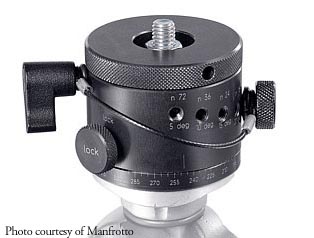 | 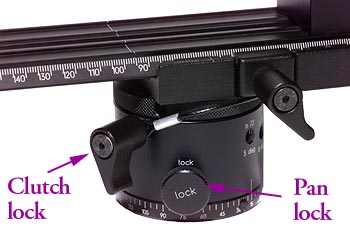 |
| Manfrotto 300N Pan Rotation Unit | Manfrotto 303SPH (includes 300N) |
Being able to select 5° or 10° increments between detents, combined with a standard camera plate connection on top of the rotator, means that you can also use the Manfrotto head as a turntable for shooting object VR movies. Simply attach a small plywood round (available from most hardware stores) centered on the top of the head, and you have an effective tripod–mounted turntable, suitable for shooting small and medium sized objects. I have also found that a laser level can be attached to this Pan Rotation Unit and used in the field to help align 5° or 10° camera positions for shooting object movie sequences around very large objects.
![]()
![]()
The Peace River 3Sixty is probably the least user-friendly head of the three because of its operational complexity. It presents the user with 12 knobs & levers to control six major functions of the head. Many of these knobs are relatively small or confined, making them difficult to adjust with gloves on. Even during normal use, finding the right knob(s) for each adjustment requires some getting used to, as they are not always positioned intuitively.
When we first mentioned these concerns, Peace River responded that the relative complexity of their head allows for additional uses, such as stereoscopic VR photography, and that there are a number of "shortcuts" that users quickly learn. None of these are described in the user manual however, so you may need to contact Peace River Studios directly for details. Peace River also felt that our "glove test" did not represent the real world in their experience, since they frequently remove their gloves to adjust equipment in sub-zero temperatures, or wind up making necessary adjustments in the relative warmth of a tent or operations base. While we very much respect their extensive shooting experience in extreme environments, we disagree. Any equipment that requires removal of gloves and the touching of bare skin to metal in order to operate successfully (no matter how briefly) can result in frostbite and potential loss of fingers in sub-zero temperatures.
There is one knob used to adjust the tension of the detent spring on the 3Sixty which I have cut my fingers on twice during testing. When the spring is stretched and locked, the knob’s small size and tension require significant finger pressure to loosen. When it does release, the tension from the spring can snap it away, tearing a groove of skin from your finger. Peace River has said that this problem is apparently due to a poorly manufactured knob on the unit they shipped to us, and that they've had no other complaints. However, they indicated that future versions of the head will have a larger knob in this position, and that the edges will be further chamfered so they are not so sharp.
Another initial concern we had with the Peace River 3Sixty head was that it appeared to have only a 1/4”-20 thread receptacle for mounting the head to a tripod. Most tripod heads are attached via a much beefier 3/8”-16 bolt. Peace River informed us that the second hole on the base of the head is indeed a 3/8"-16 threaded receptacle. It's hard to tell that this offset hole is a threaded mounting point because of the rubber material cut so close around it. Peace River says this will also be fixed in future versions.
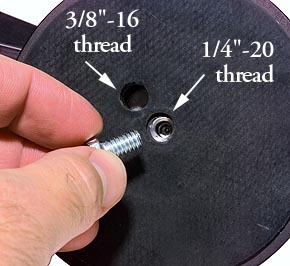 | 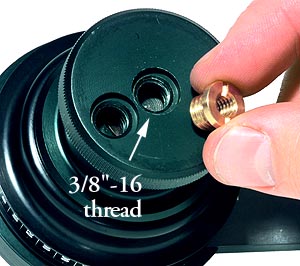 |
| Peace River Studios' 3Sixty tripod attachment | Kaidan's QuickPan III tripod attachment |
The Kaidan QPIII head is designed to attach to a tripod with a 3/8”-16 mount, but comes with a brass insert that converts this to a 1/4”-20 thread, if desired. These “step down” thread adapters are available at many photography and hardware stores, but the one that ships with the Kaidan head is one of the better ones. It has a slotted head so it can be inserted or removed with a coin or a flat head screwdriver.
The Kaidan rotators include a second 3/8” receptacle in the base for storing this adapter when not in use. Unfortunately, the thread adapters did not screw all the way in to these receptacles on the heads we received, and blocked the mounting of the heads on the tripod. This meant that the adapters had to be removed and stored elsewhere (so they’re more likely to get lost or misplaced). Kaidan indicated that this was a manufacturing problem on a recent batch of rotators, but that this problem would be corrected as a warranty fix.
The Manfrotto 303SPH comes with only a 3/8” tripod mounting receptacle. We encourage using a 3/8” mount for all three heads, particularly if you are mounting a heavier camera or using the head in non-vertical positions, such as on a boom arm through a window or sunroof for a car interior, or perhaps hanging it over the edge of a cliff, on the the side of a building, or even inverted from an overhead support. I believe the Manfrotto head is probably the best choice for such non-traditional positioning, because of both its robust design and its pan rotation lock.
![]()
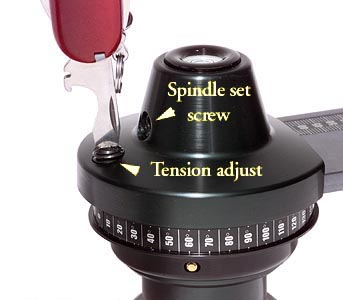 |
| Kaidan's QuickPan III detent tension adjust. Note adjacent set screw, which holds the rest of the system to the rotator spindle. |
Kaidan responded to this concern by saying that they have never had a unit come apart under any load, including hanging over 200 lbs. from the stainless steel bar (not recommended). There is a machined flat on the bearing face, and the set screw is held in place with LocTite®. While we would warn users against trying this, we couldn't resist testing Kaidan's 200 lb. claim. The aluminum rotator they sent us pulled apart with about 50 lbs. of weight (far beyond Kaidan's recommended limits), but the stainless steel version held over 200 lbs. in an inverted position for the several seconds we were able to hang on to it. Suffice it to say, we were impressed (but still warn that the head is not designed for this sort of use).
The lack of a pan locking mechanism on both the Kaidan and Peace River heads means that it's almost impossible to keep the camera from rotating under its own weight when the head is in a non-upright position. You can set a fair bit of detent tension on the 3Sixty by tightening the tension spring (note previous warning about cut fingers). This will suffice to hold the camera in many positions beyond upright. However, we have found that even with the spring stretched and locked in its maximum position, there is not enough tension to hold all detents when a heavier camera and lens are used in a 90-degree off-axis orientation. Peace River suggests removal of the small rubber 'tire" from the detent indexing wheel, which will create additional rotational resistance.
![]()
Captive Parts
Another reliability feature we looked for is whether critical parts of the heads were held captive while being adjusted. For example, if the screw that attaches a camera to the head needs to be completely removed, it can accidentally be dropped or lost, rendering the head somewhat useless. A good head design allows such parts to be loosened, but keeps them attached to the mechanism so they won’t be lost accidentally.
Both the Kaidan and Peace River heads are well designed in this regard. Critical parts are either held captive or do not require full removal when adjustments are made. The Manfrotto head also maintains this for most of its functions. However, there are two critical pieces on the 303SPH where this is not the case, and loss of either of these parts can render the head unusable.
The first is a threaded knob that secures the vertical arm in an upright position. In order to unfold the hinged arm, this knob must be unscrewed from one hole and then tightened into another to lock the arm upright. The addition of a simple keeper on this knob, or a redesign of the hinge lock to allow use of the same threaded hole in both folded and unfolded positions, would eliminate this problem. Manfrotto has already indicated that a keeper is planned for future production runs of the unit.
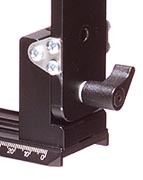 | 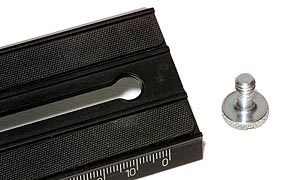 | 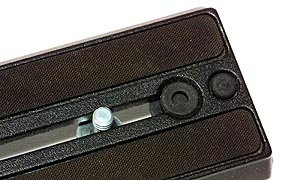 |
| Vertical arm lock knob | Non-captive screw can be dropped or lost | Captive screw remains in place |
The second problematic part is the camera attachment screw that holds the camera on the mounting plate. This screw can easily fall out of the plate when no camera is attached, leaving you with no way to secure the camera to the head. A simple solution is to include a standard Manfrotto rubber stopper on the plate, as Manfrotto does with many of their other camera plates. Since the head we received from Manfrotto was an early production model, this omission may simply have been a pre-production oversight.
![]()
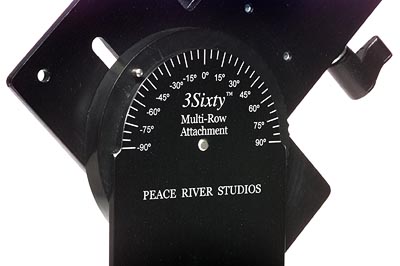 |
| Tilt detents on the Peace River 3Sixty Multi-row Attachment |
A feature we particularly liked on the Peace River 3Sixty Multi-row Attachment is the inclusion of preset detents (every 5°) on the tilt arm, along with a locking lever to clamp the tilt function. While the mechanism for this adds both complexity and cost to the design of the Multi-row Adapter, it is useful for maintaining consistent alignment and repeatability between shots.
We find that it is advantageous to at least have a detent at the zero or horizon level position, particularly if you are using the head to shoot traditional cylindrical (single row) panoramas. This helps assure that there is no slight tilt resulting in keystoning on horizon-level shots, and that the camera remains plumb. It is more difficult to assure this tilt alignment with the printed scales available on the Manfrotto and Kaidan heads. A twin axis bubble level attached to the camera is probably essential to check this on all three heads. The addition of a zero or horizon-level tilt detent on the Kaidan and Manfrotto heads would be a welcome addition.
With all of these heads, it is important for the photographer to keep a flat head screwdriver or a proper sized coin handy (a Swiss army knife or Leatherman™ tool should be a part of every photographer’s kit). This is needed to attach the camera to both the Manfrotto and Peace River heads (the Peace River Multi-row Attachment actually uses a Manfrotto camera plate assembly – although Peace River says they'll be creating their own plate assembly soon), and is also needed for the Kaidan rotator if you want to adjust detent tension.
The Kaidan heads also require a small Allen (hex) wrench or jeweler’s screwdriver if you want to change detent rings in our experience (however, Kaidan says that only the point of a ball point pen should be needed, and that this would be a warranty fix). Furthermore, if you choose the Kaidan Quick Release configuration, you’ll need to keep a 5/32” Allen wrench handy to attach or remove the Arca-Swiss plate from your camera.
![]()
The Manfrotto and the Kaidan heads incorporate modular designs that take advantage of parts and elements that are interchangeable with many of their other products. For example, the Kaidan rotators can be used with a wide variety of Kaidan brackets and attachments, and are generally interchangeable. This not only helps keep manufacturing costs lower, but also means Kaidan needs to stock fewer replacement parts. Kaidan chose such a design in response to their customers' requests to allow quick changes between camera brackets, such as their spherical bracket and their fisheye bracket.
Manfrotto’s 303SPH also incorporates assemblies from other Manfrotto products. While there are certainly advantages to this approach, in Manfrotto’s case, the reliance on existing assemblies meant that their new head wound up being a bit bulkier and heavier than it could have been with a ground-up redesign. On the other hand, by incorporating existing hardware, Manfrotto has been able to keep the retail price(s) of their new head significantly lower than those of their competitors.
![]()
Leveling Devices
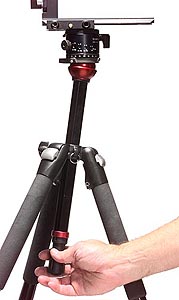 |
| Manfrotto MDeVe Leveling Center Post |
Many panoramic photographers use either a geared head or a standard ball head for an economical approach to this. Unfortunately, doing so adds bulk and weight to the equipment you have to carry. On the positive side, a ball head can also be used for most traditional tripod photography, so you may be carrying it already.
Even so, our favorite solution is a relatively new support column from Manfrotto that incorporates a ball & socket design similar to high end cinema tripods in a very small and elegant package. A grip at the bottom of the column loosens and tightens the leveling mechanism. This column replaces the existing center post on most Manfrotto tripods. Since it contains its own leveling device, it gives you many of the benefits of a ball head without extra bulk or weight (its adjustment range is considerably less than a traditional ball head, however). Several models are available to fit most Manfrotto tripods (Models 554, 555 and 556, along with Manfrotto’s MDeVe video tripod line).
![]()
Both Manfrotto and Kaidan offer alternate leveling bases that employ three threaded horizontal wheels. Their range of adjustment is quite limited, but they do offer fairly precise leveling control. Manfrotto’s 338 Leveling Base weighs about 1 lb. 5 oz. while Kaidan’s version – the QuickTilt Leveler, weighs almost 30 percent less (about 15 oz.) and sells for $149.95 (or $120.00 if purchased along with a head direct from Kaidan).
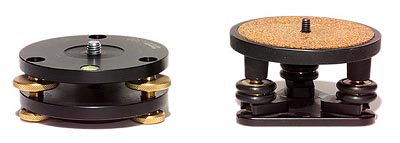 |
| Manfrotto 338 Leveling Base (left) and Kaidan QuickTilt leveler |
![]()
Other Pan Heads
While we have focused this review on the high end models from the three manufacturers, there are additional configurations from each that we should touch upon for reference.
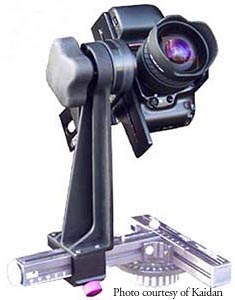 | 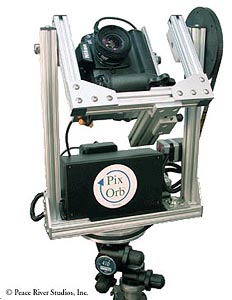 |
| Kaidan Spherical arm for Peace River 3Sixty | Peace River Studios' automated PixOrb™ |
Peace River Studios offers its 3Sixty without the Multi-row Attachment for $645. This model is acceptable if you only plan to shoot single row or cylindrical panoramas. However, if you want multi-row capability (for cubic or spherical panoramas), you will need to purchase Peace River’s Multi-row Attachment for an additional $545. An alternative is available from Kaidan however, which offers the Kaidan Spherical Arm attachment for the Peace River 3Sixty for $349.95 – a 35 percent savings over the Peace River attachment. If you already own a Peace River 3Sixty and want to add multi-row shooting capability, you might want to consider this option. Note that Peace River Studios has not tested and does not provide technical support for the Kaidan Spherical Arm, however.
Peace River also offers an automated pan head called the PixOrb, which offers motorized remote operation of both camera triggering and multi-row pan sequencing. The unit is significantly more expensive than the manually operated 3Sixty, but can be operated independently in the field or via custom Peace River software running on a Macintosh computer.
![]()
Manfrotto continues to offer two of its earlier VR head models along with their new 303SPH head. These are their original 303 Pan Head and 303Plus Precision Pan Head (the Plus version features micro positioning plates for micrometer-type front/back and left/right adjustments). Both of these models are fairly dated in our opinion, and are far less desirable than the improved design of the new 303SPH. However, if you already own one of these older models and want to add multi-row capability to it, Kaidan again offers its Spherical Arm attachment for these heads for $349.95. Keep in mind that this price however, is about $150 less than the B&H retail price for a new Manfrotto 303SPH. The Kaidan arm does not attach to the new 303SPH head.
![]()
Kaidan of course, is the market leader in terms of the variety of different VR products they offer, since their only business is VR-related products.
In addition to a multitude of QuickPan III configurations available, Kaidan offers lower priced camera specific (CS) models designed primarily for Nikon’s lightweight prosumer digital cameras. These packages include a QuickPan III CS head (featuring the same rotator as the other QPIII models) and a selection of cradle kits designed for mounting specific cameras. Prices range between $245 and $270, depending upon the camera you use. Different from previous camera-specific heads, the QuickPan III CS doesn’t require you to replace the whole head when you update your camera to a newer model in the future. Simply purchase a new cradle kit ($14.95 to $39.95) and the new camera will fit on the same QPIII CS head (note that only the Nikon Coolpix camera line is supported at this time).
![]()
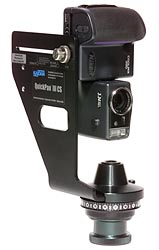 |
| Kaidan's QuickPan III CS (Camera Specific) with Nikon Coolpix 990 |
Of course, one of the chronic problems with consumer digital cameras, including the Nikon Coolpix line, is that their image sensors are not always properly aligned inside the camera. In the case of our Coolpix 990, the image sensor is rotated about 1/2 a degree from the base of the camera. Be sure to check the alignments of your own camera and head combination by shooting a series of controlled tests before relying on the setup for an important shoot. Once again, the addition of a shim (several layers of gaffer's tape, or even a coin, works well) under one side of the camera base before attaching it to the mounting plate can offer a low-cost correction for such misalignments.
![]()
Final Thoughts
Design of a VR pan head seems simple on the surface – simply attach an L-bracket (to orient the camera vertically) on top of a panning rotator unit. However, the reality of a good design is far more complex when one has to include the ability to align all the necessary camera movements (front/back, left/right, tilt up/down, panning and leveling) with the variable nodal point positions of an almost infinite variety of camera and lens combinations.
Many photographers have designed and built their own custom heads. Some of these are quite elegant and offer an ideal combination of function, small size, low weight and low cost. This is possible because they are designed for a specific camera and lens. Designing similar hardware as a commercial product demands accommodation of multiple camera/lens combinations, manufacturing efficiency and a number of tradeoffs between size, weight, functionality and price.
The VR community is indeed fortunate to have these three leading companies, along with a small handful of others, producing commercial VR hardware and continually improving their products. They’ve helped photographers come a long way from the early days of VR, when most of us had to build our equipment from scratch or to assemble it from a variety of expensive and often hard to find products designed for other uses. The results were generally cumbersome and user “unfriendly”.
While we may still discover occasional flaws in these top commercial VR heads, they do represent the best of what’s available today. They are the result of many thousands of hours of design, manufacturing, testing and improvement that none of us could have accomplished on our own.
We at Virtual Reality Photography hope you will consider these manufacturers’ products favorably when making your own equipment choices.
![]()
Contact info:
|
| Kaidan: www.kaidan.com Manfrotto: www.manfrotto.com Peace River Studios: www.peaceriverstudios.com |
![]()